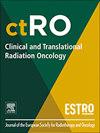An offline adaptive planning method based on delivered accumulated dose for brachytherapy in cervical cancer
IF 2.7
3区 医学
Q3 ONCOLOGY
引用次数: 0
Abstract
Background and purpose
In current clinical practice, independent treatment plan optimization for each fraction of brachytherapy might not be able to fully leverage the dosimetric advantage of the cervical cancer radiotherapy combining external beam radiotherapy (EBRT) and brachytherapy (BT). This study proposed an offline adaptive planning method based on accumulated dose for BT, aiming to improve the total dose distribution of the combined radiotherapy.
Methods and materials
This study retrospectively reviewed nine cervical cancer patients treated with EBRT followed by high-dose-rate BT. For each BT fraction, we used a multi-metric deformable image registration method to accumulate the dose distributions of previously delivered EBRT and BT. The accumulated dose distribution was then imported into a customized commercial BT treatment planning system as a background in the adaptive dose optimization. Main dosimetric parameters of the target and organs at risk (OARs) were compared between the adaptive BT (ABT) and conventional BT (CBT) planning methods.
Results
For approximately 70 % of the BT fractions, the ABT plans have lower D2cc to the bladder or rectum compared with the CBT plans. In terms of total dose evaluation, the ABT planning method resulted in a decrease in mean values of D2cc, V60 and V50 for the bladder (–1.9 ± 2.0 GyEDQ2, –1.2 ± 1.2 %, and –0.9 ± 1.1 %) and rectum (–2.1 ± 1.8 GyEQD2, –1.2 ± 1.2 %, and –1.4 ± 1.3 %).
Conclusion
The offline adaptive planning method could help decrease the doses to OARs and improve the total dose distribution of combined radiotherapy, showing promising prospects for clinical use.
基于传递累积剂量的宫颈癌近距离放疗离线自适应规划方法
背景与目的在目前的临床实践中,对近距离放疗的各个部分进行独立的治疗方案优化,可能无法充分发挥宫颈癌放疗联合外束放疗(EBRT)和近距离放疗(BT)的剂量学优势。本研究提出了一种基于累积剂量的BT离线自适应规划方法,旨在改善联合放疗的总剂量分布。方法与材料本研究回顾性分析了9例接受EBRT和高剂量率BT治疗的宫颈癌患者,对于每个BT部分,我们使用多度量可变形图像配准方法累积先前传递的EBRT和BT的剂量分布,然后将累积剂量分布输入定制的商业BT治疗计划系统中,作为自适应剂量优化的背景。比较了自适应BT (ABT)和常规BT (CBT)计划方法的靶器官和危险器官(OARs)的主要剂量学参数。结果约70%的BT分数,ABT方案比CBT方案对膀胱或直肠的D2cc更低。在总剂量评估方面,ABT计划方法导致膀胱(-1.9±2.0 gyeqq2, -1.2±1.2%,-0.9±1.1%)和直肠(-2.1±1.8 GyEQD2, -1.2±1.2%,-1.4±1.3%)的D2cc、V60和V50平均值下降。结论离线自适应规划方法有助于降低OARs的剂量,改善联合放疗的总剂量分布,具有良好的临床应用前景。
本文章由计算机程序翻译,如有差异,请以英文原文为准。
求助全文
约1分钟内获得全文
求助全文
来源期刊

Clinical and Translational Radiation Oncology
Medicine-Radiology, Nuclear Medicine and Imaging
CiteScore
5.30
自引率
3.20%
发文量
114
审稿时长
40 days
 求助内容:
求助内容: 应助结果提醒方式:
应助结果提醒方式:


